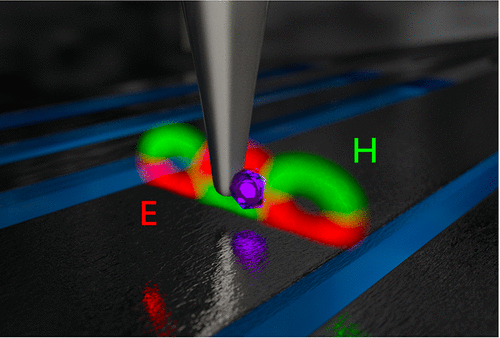当前位置:
X-MOL 学术
›
Nano Lett.
›
论文详情
Our official English website, www.x-mol.net, welcomes your feedback! (Note: you will need to create a separate account there.)
Exploring the Magnetic and Electric Side of Light through Plasmonic Nanocavities
Nano Letters ( IF 10.8 ) Pub Date : 2018-07-12 00:00:00 , DOI: 10.1021/acs.nanolett.8b01956 Cyrine Ernandes , Hung-Ju Lin , Michel Mortier 1 , Patrick Gredin 1 , Mathieu Mivelle , Lionel Aigouy
Nano Letters ( IF 10.8 ) Pub Date : 2018-07-12 00:00:00 , DOI: 10.1021/acs.nanolett.8b01956 Cyrine Ernandes , Hung-Ju Lin , Michel Mortier 1 , Patrick Gredin 1 , Mathieu Mivelle , Lionel Aigouy
Affiliation

|
Light–matter interactions are often considered to be mediated by the electric component of light only, neglecting the magnetic contribution. However, the electromagnetic energy density is equally distributed between both parts of the optical fields. Within this scope, we experimentally demonstrate here, in excellent agreement with numerical simulations, that plasmonic nanostructures can selectively manipulate and tune the magnetic versus electric emission of luminescent nanocrystals. In particular, we show selective enhancement or decay of magnetic and electric emission from trivalent europium-doped nanoparticles in the vicinity of plasmonic nanocavities, designed to efficiently couple to either the electric or magnetic emission of the quantum emitter. Specifically, by precisely controlling the spatial position of the emitter with respect to our plasmonic nanostructures, by means of a near-field optical microscope, we record local distributions of both magnetic and electric radiative local densities of states (LDOS) with nanoscale precision. The distribution of the radiative LDOS reveals the modification of both the magnetic and electric optical quantum environments induced by the presence of the metallic nanocavities. This manipulation and enhancement of magnetic light–matter interaction by means of plasmonic nanostructures opens up new possibilities for the research fields of optoelectronics, chiral optics, nonlinear and nano-optics, spintronics, and metamaterials, among others.
中文翻译:

通过等离子纳米腔探索光的磁和电面
通常认为光-物质相互作用仅由光的电子成分介导,而忽略了磁性。然而,电磁能量密度在光场的两个部分之间均等地分布。在此范围内,我们通过与数值模拟的极佳实验证明,等离子体纳米结构可以选择性地操纵和调整发光纳米晶体的磁发射与电发射。特别是,我们显示了等离激元纳米腔附近的三价-掺杂纳米粒子的磁和电发射的选择性增强或衰减,这些粒子设计为有效地耦合到量子发射器的电或磁发射。具体来说,通过使用近场光学显微镜精确控制发射器相对于我们的等离子体纳米结构的空间位置,我们以纳米级精度记录了磁和电辐射局部态密度(LDOS)的局部分布。辐射LDOS的分布揭示了由于金属纳米腔的存在而引起的磁和电光量子环境的改变。通过等离激元纳米结构的这种操纵和增强的磁光-物质相互作用为光电子学,手性光学,非线性和纳米光学,自旋电子学和超材料等领域的研究开辟了新的可能性。我们以纳米级精度记录磁和电辐射局部状态密度(LDOS)的局部分布。辐射LDOS的分布揭示了由于金属纳米腔的存在而引起的磁和电光量子环境的改变。通过等离激元纳米结构的这种操纵和增强的磁光-物质相互作用为光电子学,手性光学,非线性和纳米光学,自旋电子学和超材料等领域的研究开辟了新的可能性。我们以纳米级精度记录磁和电辐射局部状态密度(LDOS)的局部分布。辐射LDOS的分布揭示了由于金属纳米腔的存在而引起的磁和电光量子环境的改变。通过等离激元纳米结构的这种操纵和增强的磁光-物质相互作用为光电子学,手性光学,非线性和纳米光学,自旋电子学和超材料等领域的研究开辟了新的可能性。
更新日期:2018-07-12
中文翻译:

通过等离子纳米腔探索光的磁和电面
通常认为光-物质相互作用仅由光的电子成分介导,而忽略了磁性。然而,电磁能量密度在光场的两个部分之间均等地分布。在此范围内,我们通过与数值模拟的极佳实验证明,等离子体纳米结构可以选择性地操纵和调整发光纳米晶体的磁发射与电发射。特别是,我们显示了等离激元纳米腔附近的三价-掺杂纳米粒子的磁和电发射的选择性增强或衰减,这些粒子设计为有效地耦合到量子发射器的电或磁发射。具体来说,通过使用近场光学显微镜精确控制发射器相对于我们的等离子体纳米结构的空间位置,我们以纳米级精度记录了磁和电辐射局部态密度(LDOS)的局部分布。辐射LDOS的分布揭示了由于金属纳米腔的存在而引起的磁和电光量子环境的改变。通过等离激元纳米结构的这种操纵和增强的磁光-物质相互作用为光电子学,手性光学,非线性和纳米光学,自旋电子学和超材料等领域的研究开辟了新的可能性。我们以纳米级精度记录磁和电辐射局部状态密度(LDOS)的局部分布。辐射LDOS的分布揭示了由于金属纳米腔的存在而引起的磁和电光量子环境的改变。通过等离激元纳米结构的这种操纵和增强的磁光-物质相互作用为光电子学,手性光学,非线性和纳米光学,自旋电子学和超材料等领域的研究开辟了新的可能性。我们以纳米级精度记录磁和电辐射局部状态密度(LDOS)的局部分布。辐射LDOS的分布揭示了由于金属纳米腔的存在而引起的磁和电光量子环境的改变。通过等离激元纳米结构的这种操纵和增强的磁光-物质相互作用为光电子学,手性光学,非线性和纳米光学,自旋电子学和超材料等领域的研究开辟了新的可能性。



























 京公网安备 11010802027423号
京公网安备 11010802027423号